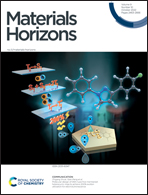Fracture-controlled surfaces as extremely durable ice-shedding materials†
Abstract
Icing imposes a significant burden on those living in cold climates, with negative impacts on infrastructure, transportation, and energy systems. Over the past few decades, a wide range of materials with ice-shedding characteristics have been developed, including surfaces that are non-wetting/hydrophobic, liquid-infused, stress-localized, and those with low interfacial toughness. Although many of these materials have demonstrated low ice adhesion in a laboratory setting, none have achieved widespread practical adoption. This is primarily a result of the fact that they tend to have very low durability, limiting their applicability. Thus, the primary challenge in developing ice-shedding materials is finding materials with both low ice adhesion AND good durability. Here, we introduce the concept of a so-called “fracture-controlled surface.” Through coordinated mechanical and chemical heterogeneity in the material structure, we affect the interfacial crack nucleation and growth on these surfaces. Through this controlled process, fracture-controlled surfaces exhibit both low ice adhesion and very high mechanical durability. Measurements of the durability of these surfaces indicate performance that is three orders of magnitude greater than other state-of-the-art ice-shedding materials. Physically, via mechanical heterogeneity of the material, we pre-specified the crack nucleation coordinates at the interface and guided the crack growth in an interfacial plane, with no kinking in other directions. This helps to maximize the energy that goes towards crack nucleation and growth. A detailed mathematical model is developed to predict adhesion of external solid objects on these materials. The model suggests that an elastic matching criterion is required to achieve minimal adhesion of solid objects on these materials. Fracture-controlled surfaces provide a rich material platform to guide future innovation of materials with minimal adhesion while having very high durability.



 Please wait while we load your content...
Please wait while we load your content...